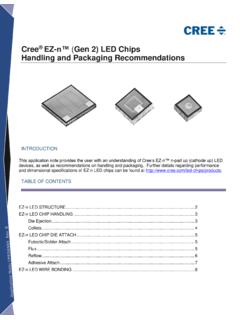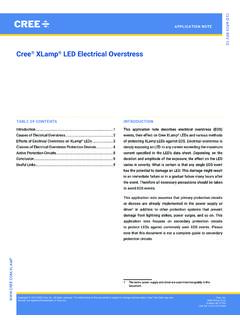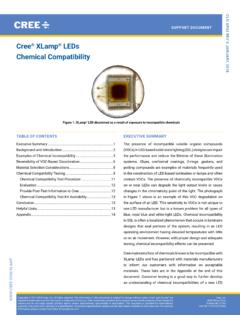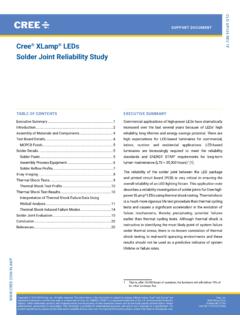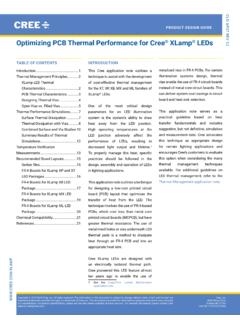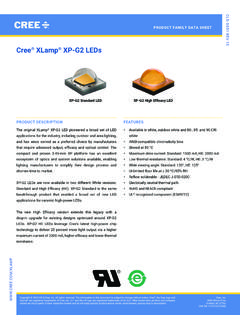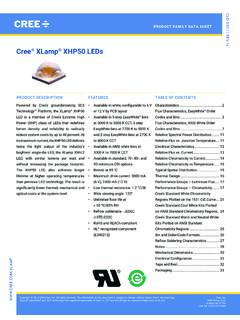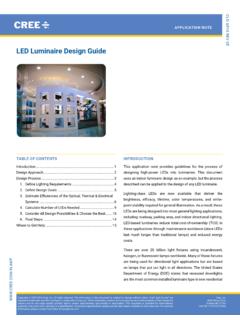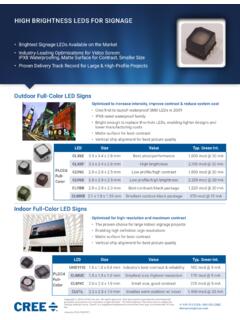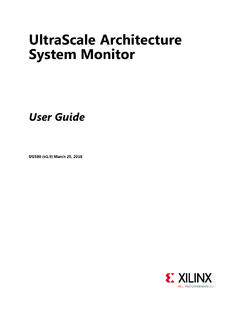Transcription of Eye Safety with LED Components - Cree Inc.
1 CLD-AP34 rev 22. technical article Eye Safety With LED Components Table of Contents Photobiological Standards and Regulations for LED Summary Test XLamp 10. MT-G EasyWhite .. 10. 10. 10. 10. 10. 10. XHP35 High 10. XHP35 High 10. 10. 11. 11. 11. XM-L .. 11. XM-L 11. XM-L 11. XM-L High Voltage 11. 11. 11. 12. XP-E High Efficiency 12. 12. 12. 12. 12. XP-L High 12. XP-L High 12. 12. XQ-E High 13. XQ-E High 13. 13. 13. XT-E High 13. XT-E High Voltage 13. LED 13. 13. 13. Copyright 2009- 2018 Cree, Inc. All rights reserved. The information in this document is subject to change without notice. Cree, XLamp and Cree, Inc. EasyWhite are registered trademarks and XM-L and the Cree logo are trademarks of Cree, Inc. This document is provided for informational 4600 Silicon Drive purposes only and is not a warranty or a specification.
2 For product specifications, please see the data sheets available at For warranty Durham, NC 27703. information, please contact Cree Sales at USA Tel: + Eye Safety with LED Components Introduction This application note explains the current standards and regulations related to LED Components (both packaged LEDs and LED light engines or modules) and photobiological Safety . It also provides guidance for expected maximum risk group classifications for Cree's visible light LED Components in accordance with these standards. Visible light LED Components , as that term is used in this document, include both white LEDs and LED modules and colored LEDs with the dominant wavelengths between 400 nm and 680 nm. At a high enough intensity, all light sources have the potential to be harmful to both the skin and the eyes through ultraviolet (UV), blue light (400-480 nm) and/or infrared (IR) emissions.
3 LEDs that emit blue light may be identified by multiple names, such as blue, royal blue or dental blue. (As of the date of this application note, Cree does not produce a dental blue LED). Additionally, most white packaged LEDs (including Cree's) are made using blue emitting LED die and therefore emit a portion of their total output as blue light. Cree has engaged an independent lab to conduct photobiological testing, also known as eye Safety testing, on its blue, royal blue and select white LED Components . The results of this testing (explained below in further detail) show significant health risks from some of Cree's visible light LED Components when viewed without diffusers or secondary optical devices. These risks warrant an advisory notice to indicate the potential for eye injury caused by prolonged viewing of blue light from these devices.
4 To date, the testing shows that Cree's blue and royal blue LED Components (450-485 nm dominant wavelengths) pose a higher potential eye Safety hazard than its white LED Components . Other colors of LED Components , such as green and red LED Components , do not pose as significant of an eye Safety risk. Regardless of LED color, Cree advises users to not look directly at any operating LED component. Further, Cree recommends that any manufacturer that is incorporating Cree LED Components into its lighting products make an assessment of how these Components could create a light exposure risk to its employees during the manufacturing process. Such risks can be minimized by using engineering controls ( , light blocking screens or filters, or current limiting resistors in a test apparatus) or personnel protection equipment ( , light filtering or blocking eyewear).
5 During the eye Safety testing of Cree's visible light LED Components , the LED solder-point temperature or LED module case temperature was controlled to be at or below what is normally observed in most LED luminaire (lighting fixture) designs -- this control ensures maximized, or worst case, light output. Depending on the final luminaire design, the eye Safety risks associated with a particular use of Cree LED Components could differ from data provided in this application note, or the third party test results, due to differences in operating conditions. Copyright 2009- 2018 Cree, Inc. All rights reserved. The information in this document is subject to change without notice. Cree, XLamp and EasyWhite are registered trademarks and XM-L and the Cree logo are trademarks of Cree, Inc. This document is provided for informational purposes only and is not a warranty or a specification.
6 For product specifications, please see the data sheets available at www. For warranty information, please contact Cree Sales at 2. Eye Safety with LED Components In addition to risk incident to blue light, very bright light can elevate the temperature of retinal tissue and pose a hazard. Retinal thermal hazards are defined by the intensity of visual light radiation focused by the cornea on the retina of the human eye. The image formed on the retina becomes the affected area of the eye subject to thermal damage. As shown in Figure 11, the retinal thermal hazard function includes a much broader range of wavelengths than the blue light hazard function. Figure 1: Retinal thermal and blue light hazard functions Photobiological Standards and Regulations for LED Components Before the fall of 2008, most LEDs were tested and labeled in accordance with the IEC/EN 60825 laser Safety (coherent light source).
7 Standard. The IEC/EN 60825 standard, however, was not considered appropriate for conventional packaged LEDs because most LEDs are not designed to be coherent light sources (except for laser diodes). Further, the IEC/EN 60825 standard does not define risk groups for LED luminaires, so it does not consider changes in the eye Safety risks created by elements other than individual LED Components , such as secondary optics, reflectors, or diffusers. As a result, in late 2008 a newer standard, referred to as IEC 62471-2006 (plus the supporting ANSI/IESNA RP-27 testing methodology), was adopted for conventional, or lighting class, LEDs. The detailed photobiological testing results provided below in this application note are based on the new standard and the ANSI/IESNA RP-27 testing methodology. As of the date of publication of this application note, a few countries may still refer to IEC/EN 60825 as the prevailing standard.
8 Since IEC/EN 60825 was the only Safety standard for LED Components available for many years, Cree previously tested several of its XLamp . white LEDs in accordance with the IEC/EN 60825 and found that many of them would be considered Class 2 devices under such standard. Products released in 2010 or later likely have not been tested or evaluated using IEC 60825. The summary of results presented below were performed on standalone Cree LED Components to aid in fixture design and to assess the general Safety of personnel exposed to LED-based emissions in the manufacturing setting. No single test result is meant to be indicative of all XLamp LEDs and LED modules under all operation conditions, , operation within a range of forward currents is possible with any LED. Further, the risk classification of a standalone LED component has little or no bearing on the risk classification of the final luminaire.
9 Accordingly, once Cree LED Components are incorporated into a luminaire or related LED lighting product, Cree recommends and EU. consumer and commercial directives and the IEC 62471-2006 standard generally require that the assembly be tested under ANSI/IESNA. RP-27 (or an equivalent measurement methodology) to assess the eye Safety risk of the lighting system. 1 Copyright University of Ottawa, Office of Risk Management; Photobiological Effects , Copyright 2009- 2018 Cree, Inc. All rights reserved. The information in this document is subject to change without notice. Cree, XLamp and EasyWhite are registered trademarks and XM-L and the Cree logo are trademarks of Cree, Inc. This document is provided for informational purposes only and is not a warranty or a specification. For product specifications, please see the data sheets available at www.
10 For warranty information, please contact Cree Sales at 3. Eye Safety with LED Components The IEC 62471-2006 standard specifies four (4) classifications, called risk groups, for lamps and lamp systems (excluding lasers) emitting light in wavelengths from 200 to 3000 nm as set forth in Table 1 Table 1: Risk groups Risk Group Risk Definition Exempt None No photobiological hazard RG-1 Low Risk No photobiological hazard under normal behavioral limitation RG-2 Moderate risk Does not pose a hazard due to aversion response to bright light or thermal discomfort RG-3 High risk Hazardous even for momentary exposure Summary Test Results Table 2 and Table 3 below summarize the eye Safety test results for Cree LED Components pursuant to the IEC 62471 classification system. The risks noted below are based on the measured blue light emissions.
